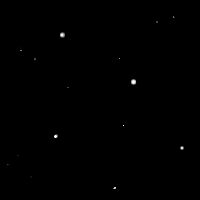How to Build a Laser Death RayTwinkle |
 The air is never still. There are currents and eddies and various turbulent swirls and plumes. These cause very small changes in the density of the air. Small changes in the density, however, will act like a weak lens to light going through them. This has two effects - light tends to get a bit defocused, and it traces a slightly erratic path as it is deflected a bit to one side or the other at every "lens." Since the atmospheric "lenses" are not stationary, a beam of light will jitter a bit as the air moves. This is what causes stars to twinkle in the night sky. It is also undesirable behavior in a death ray. Twinkle limits the divergence angle of any laser beam passing through long distances of air to about 5×10-6 radians.
The air is never still. There are currents and eddies and various turbulent swirls and plumes. These cause very small changes in the density of the air. Small changes in the density, however, will act like a weak lens to light going through them. This has two effects - light tends to get a bit defocused, and it traces a slightly erratic path as it is deflected a bit to one side or the other at every "lens." Since the atmospheric "lenses" are not stationary, a beam of light will jitter a bit as the air moves. This is what causes stars to twinkle in the night sky. It is also undesirable behavior in a death ray. Twinkle limits the divergence angle of any laser beam passing through long distances of air to about 5×10-6 radians.
Fortunately, astronomers have discovered how to correct for twinkle. After all, they want in-focus, steady views of the sky. So after the light from the stars bounces off the big light collection mirrors, it is directed to a special mirror that can be slighly deformed very precisely. The telescope instrumentation measures the amount of turbulence and lensing in the air, relays this information to the mirror controlling computer, which then deforms the mirror to exactly refocus the light, undoing all the effects of passing through the atmosphere. It does this rapidly enough to keep up with the fluctuating paths. For death rays, we do this in reverse. We measure the atmospheric lensing, then deform our mirror so that it precisely defocuses the beam in just the right way that the air lensing refocuses it on the target. This trick is called adaptive optics, and is complex and expensive, but workable. |